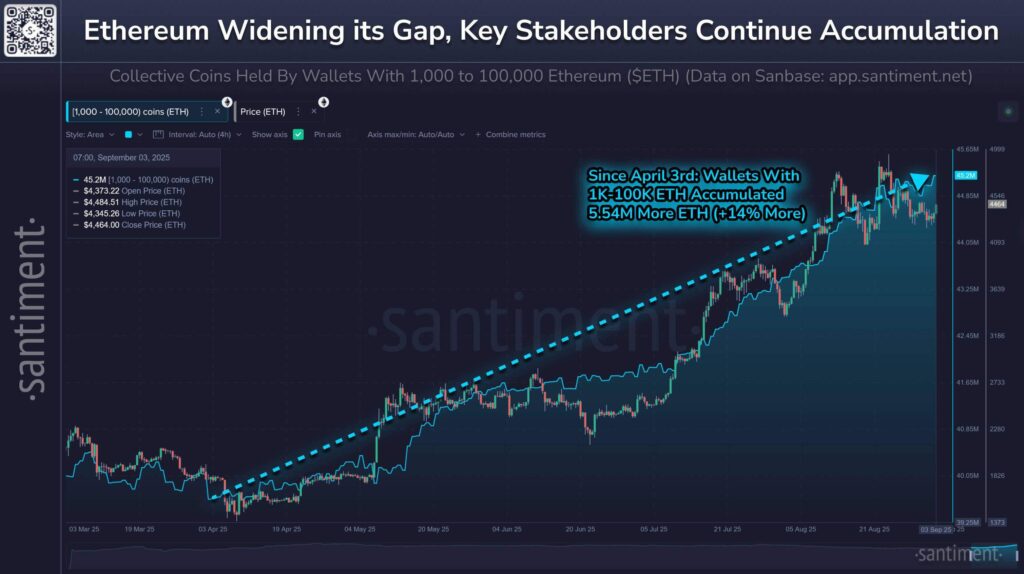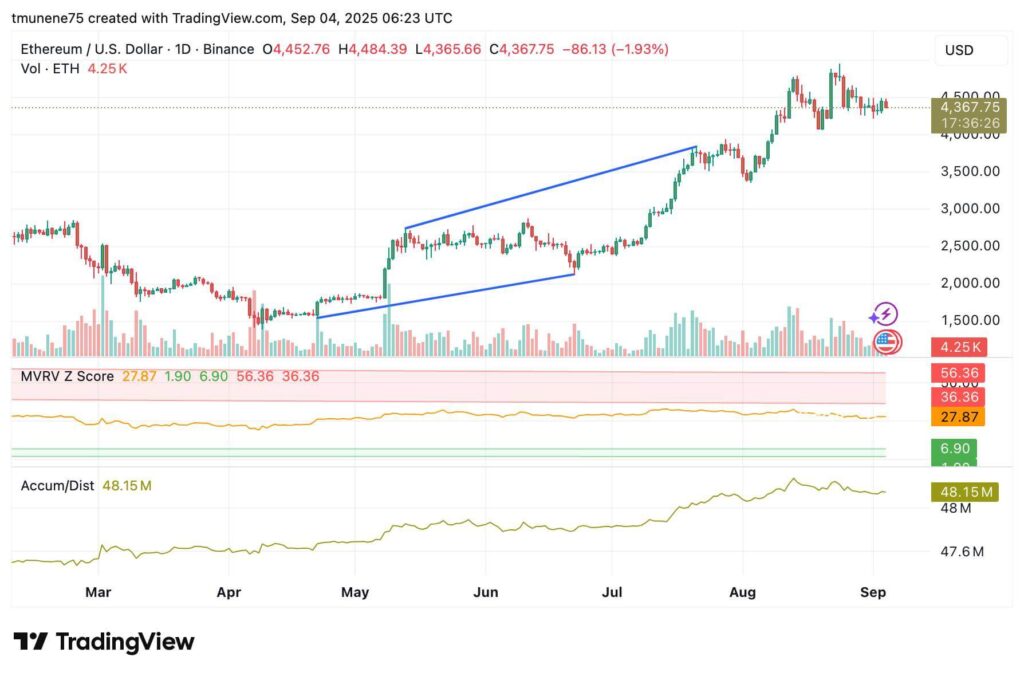Ethereum whale accumulation is driving supply concentration: wallets holding 1,000–100,000 ETH added 5.54M ETH since April, a 14% rise that pushed collective balances to 45.2M ETH and has supported a move toward $4,500 while on-chain metrics show elevated but not extreme profit levels.
-
Whales added 5.54M ETH since April, raising balances to 45.2M ETH (14% increase)
-
Price action: opened $4,452.76 on Sept 4, closed $4,366.44 — a 1.96% daily decline amid continued accumulation.
-
The MVRV Z-Score sits at 27.87, indicating substantial unrealized profits but below prior extremes.
Ethereum whale accumulation lifts supply concentration and supports the run toward $4,500; read the on-chain metrics, MVRV analysis, and short-term outlook. Learn more.
What is Ethereum whale accumulation and how does it affect price?
Ethereum whale accumulation refers to large wallets (1,000–100,000 ETH) increasing holdings. These wallets added 5.54 million ETH since April 3, 2025, raising collective balances by 14% to 45.2M ETH, which reduces circulating supply and has supported price appreciation toward $4,500.
How much ETH have whales accumulated since April 2025?
Whales accumulated 5.54M ETH from April through early September 2025. This accumulation lifted their combined holdings to 45.2M ETH, a clear 14% increase that coincided with higher lows and extended rallies during the April–July breakout phases.
Ethereum nears $4,500 as whales holding 1K–100K ETH boost balances by 14%, aligning accumulation with price uptrend.
- Ethereum whales accumulated 5.54M ETH since April, raising collective holdings to 45.2M, a 14% increase.
- Price opened at $4,452.76 on Sept 4 but closed at $4,366.44, a 1.96% daily decline.
- The MVRV Z-Score at 27.87 shows notable unrealized profits, below the peak of 56.36 linked to overheated markets.
Ethereum has returned to levels close to $4,500, with large holders steadily increasing balances over the past five months. Wallets containing between 1,000 and 100,000 ETH accumulated 5.54 million coins since April 3, 2025, tightening the available supply on exchanges.
This growth is a 14% rise in holdings, strengthening collective balances to 45.2 million ETH. Consistent buying by these so-called whales has increased supply concentration and aligned accumulation with the asset’s recent uptrend.
Why does whale accumulation matter for short-term price movement?
Whale accumulation matters because it removes ETH from circulation and from exchange inventories, reducing immediate selling pressure. The pattern of increasing large-wallet balances coincided with higher lows, extended rallies, and stronger conviction during breakout months.
Whale Accumulation and Market Impact
These investors added coins during periods of steady price appreciation, supporting Ethereum’s upward momentum. Data shows each accumulation phase coincided with higher lows and extended rallies, keeping the market on a clear uptrend.

Ethereum holders chart, Source: Santiment
As of September 3, Ethereum opened at $4,373, peaked at $4,484, dipped to $4,345, and closed at $4,464. The dotted trendline tracking whale balances and price movements indicates a firm upward slope despite some consolidation after August highs.
How did price move in the short term and what is the supply outlook?
On September 4, Ethereum opened at $4,452, reached $4,484, fell to $4,365, and closed at $4,366 — a 1.96% daily decline. Prices remain above mid-year breakout levels formed during the April–May breakout from sub-$2,000 ranges.
Earlier in 2025, Ethereum traded below $2,000 before breaking out in April and May, forming an ascending channel that lifted it toward $4,500. Reduced circulating supply due to accumulation has been a structural factor supporting this trend.
What do on-chain metrics say and why should investors be cautious?
On-chain metrics demonstrate sustained inflows. The Accumulation/Distribution line stands at 48.15M, reflecting consistent buying despite consolidation. Volume was strongest from April through July, with lighter sessions more recently.

ETH/USD 1-day price chart, Source: TradingView
The MVRV Z-Score is 27.87, which signals notable unrealized profits but remains well below prior extremes such as 56.36 that have aligned with overheated conditions. This implies the market is elevated but not yet at historically extreme profit levels.
Frequently Asked Questions
Are whales driving Ethereum to $4,500?
Whale accumulation contributes to supply tightening and has supported price momentum toward $4,500, but price action also depends on broader market liquidity, macro conditions, and retail participation.
What does an MVRV Z-Score of 27.87 indicate?
An MVRV Z-Score of 27.87 indicates substantial unrealized profits among holders. It is elevated but below historical peaks that signaled market overheatings, suggesting caution without immediate overextension.
How can investors track whale accumulation?
Investors can monitor large-wallet balance changes, Accumulation/Distribution lines, and exchange reserves. Consistent increases in large-holder balances and falling exchange supply typically indicate stronger accumulation pressure.
Key Takeaways
- Whale accumulation: 5.54M ETH added since April raised large-holder balances to 45.2M ETH (14% increase).
- Price context: Ethereum approached $4,500 but had a 1.96% daily decline on Sept 4; momentum remains intact.
- On-chain signals: Accumulation/Distribution at 48.15M and MVRV Z-Score of 27.87 show elevated profits but not overheated extremes.
Conclusion
Ethereum whale accumulation has materially tightened supply and supported the rally toward $4,500, backed by Accumulation/Distribution and a moderate MVRV reading. Market participants should monitor large-wallet flows and exchange reserves for signs of continued accumulation or distribution. For ongoing coverage, consult COINOTAG updates and on-chain metrics reports.
